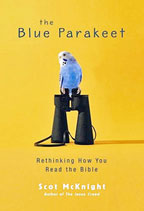Part 1 of series: Thin Places
Permalink for this post / Permalink for this series
I first heard someone use the phrase “thin place” about fifteen years ago. She had become a devotee of Celtic spirituality, from which source she had discovered the label “thin place.” She was terribly enthusiastic about the idea of “thin places,” and proceeded to use this phrase to excess, which didn’t add to my enthusiasm for the phrase. Nevertheless, she got me thinking about thin places for the first time.
 Celtic spirituality, by the way, has nothing to do with Boston’s basketball team. The word “Celtic” (pronounced KEL-tik, in this case) refers to a variety of Christian devotion practiced in Ireland and Scotland since the fifth century A.D. In recent years, there has been a revival of interest in Celtic spirituality, partly because of the popularity of Celtic religious art, and partly because of the wide influence of the Iona Community, a Christian community on the Scottish island of, you guessed it, Iona. (Photo: A Celtic cross on the island of Iona.)
Celtic spirituality, by the way, has nothing to do with Boston’s basketball team. The word “Celtic” (pronounced KEL-tik, in this case) refers to a variety of Christian devotion practiced in Ireland and Scotland since the fifth century A.D. In recent years, there has been a revival of interest in Celtic spirituality, partly because of the popularity of Celtic religious art, and partly because of the wide influence of the Iona Community, a Christian community on the Scottish island of, you guessed it, Iona. (Photo: A Celtic cross on the island of Iona.)
The woman who introduced me to the phrase “thin place” explained its meaning. “A thin place,” she said, “is a place where the boundary between heaven and earth is especially thin. It’s a place where we can sense the divine more readily.” I wondered why this person, a respected Christian leader, seemed to have a hard time speaking of relationship with God. “Thin place” almost functioned as a circumlocution, a way getting around actually saying “God is especially present here.” I also wondered about the whole idea of thin places. Are there such places? If so, why are they thin? Something about the whole notion of thin places made me nervous, theologically speaking, but I couldn’t quite put my finger on the problem.
Since my first exposure to the phrase “thin place,” I’ve probably heard it used five hundred times, maybe more. In certain Christian circles, Celtic Christianity has become wildly popular, and so has the use of “thin place” to describe places where people experience God (or “the divine,” if you prefer). I have tended to resist this language, partly because of its trendy overuse, and partly because of my nagging discomfort about its meaning.
Well, in the irony of God’s sovereignty, I’ve ended up in a place that people love to identify as thin. In my eighteen months as Senior Director of Laity Lodge, I’ve heard Laity Lodge described as a thin place probably a hundred times or more. When people say this, they mean to compliment Laity Lodge as an unusual place that fosters intimacy with God. For them, the barrier between earth and heaven does seem to become very thin at Laity Lodge. They have experienced God with more immediacy and intimacy when on retreat in the Frio River canyon than in their ordinary lives. In many cases, people have had life-transforming experiences at Laity Lodge through the presence and power of God’s Spirit.
Beginning today, I want to reflect a bit on the notion of thin places (sometimes called thin spaces). I’m not starting this blog series with a clear sense of where I’m headed. And I’m not planning to grind any particular axe. Rather, I want to think about the idea of thin places, especially in light of Scripture. I want to consider what makes a place thin, and how this description might be helpful (or not).
As always I’m interested in your comments. What do you think of the language of “thin places”? Have you ever experienced something you might call a thin place? Where? What happened?
Stay tuned . . . .
More from Beliefnet and our partners

